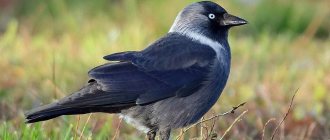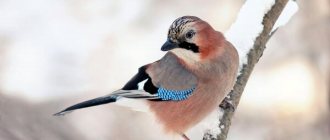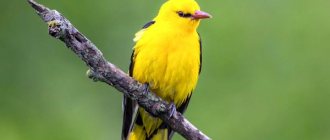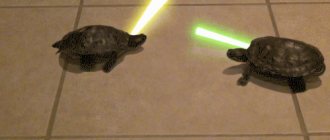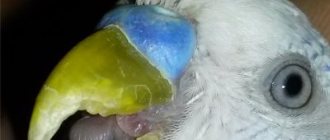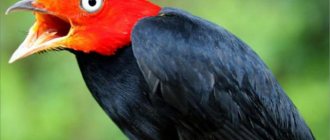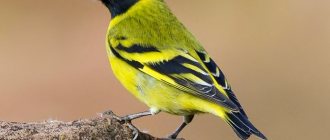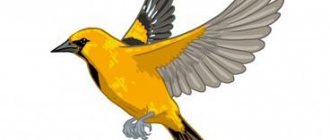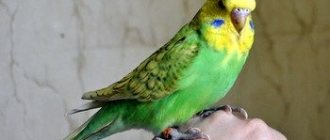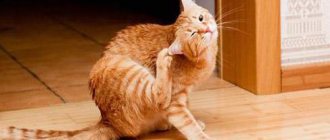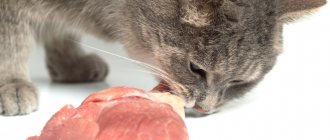General information
The toucan belongs to the order Woodpeckers. It got its name due to the characteristic loud “toka-toka” sounds that it makes.
The total weight of an adult toucan does not exceed 300-330 grams. The massive beak adds virtually no weight since it is hollow inside. Its dimensions are slightly less than its body length (50-60 cm) and are about 45 cm. The bird uses its beak as a tool for obtaining food, and not for protection.
Depending on the variety, the color of the plumage varies from black to emerald. The toucan's beak is a bright orange-yellow color with a black tip that is slightly curved downwards. In some species, the color range of the “dignity” varies from greenish to chocolate.
The lifespan of a healthy individual is 30-50 years.
Features of the toucan bird (video)
The most remarkable part of this bird’s body, its beak, deserves special attention. This organ, despite its massiveness, is hollow inside and therefore weighs little. The keratin it is made of is a fairly durable material. Toucans use their beaks as a multifunctional tool. It allows the bird to navigate the flock and be a full part of it.
Messengers of warmth: species of starlings and their habitat
Toucans also use their beaks to obtain food, as well as peel and peel fruits and nuts. There are notches on the top. They make it easier to pick up and swallow food. The end of the beak is slightly rounded. This part of the bird’s body is also involved in heat exchange. The impressive size of the beak can be used to scare away predators. The bird with a large beak has a very long tongue with fringed edges. Birds are able to pronounce extremely diverse sounds, so they are often compared to parrots due to their ability to imitate.
Toucans have relatively short wings. Due to their long beak they are not very good fliers. Long migrations are not typical for them. Only rare individuals can make fairly short flights within one area. Toucans have very long and tenacious legs, which allow them to hold on to branches well. Thanks to strong fingers and developed joints, they can move along branches by jumping.
The best breeds of geese for breeding at home
Habitat
In the wild, the bird lives in Central America, Brazil and Argentina. This is a forest dweller who prefers dense vegetation located on the plain. The toucan also settles much less frequently in the mountains. The maximum height comfortable for the bird does not exceed 3 kilometers above sea level.
Toucans are not inclined to build nests and arrange them independently. They live in tree hollows, as well as in the homes of other birds. These birds do not disdain looting. It is not difficult for them to drive their owners out of their own home and settle there if these birds are inferior to them in physical capabilities.
Basic information about the toucan bird
The average person should stop comparing birds with parrots. The toucan is classified as a woodpecker; in nature there are about 36 species of these birds. The animal makes a lot of noise and shouts something similar to the word “tokano”. This is where it got its name.
- The toucan bird is completely unsuited to long flights, so it spends most of its life in hollows and treetops, where it feeds on fruits. It takes off and, having gained the required altitude, glides towards the desired area.
- The feathered beast is notable for its extravagant appearance. The large yellow beak is immediately etched into the memory of people who pay attention to it. The length of the bird's nose is almost half the length of the body.
- The plumage has contrast and bright colors. The main tone is black, on which various colorful patterns spread. The lower limbs and areas around the eyes are also brightly colored.
- The tail of toucans is not very long, has a straight cut and consists of ten feathers. However, some species are distinguished by the completely opposite structure of this part of the body.
- If we pay attention to the lower limbs, we will see that they are endowed with great strength and four fingers, which help the feathered animal climb trees.
- The toucan bird behaves quite calmly and docilely. It is not difficult to make it manually, since it does not mind spending leisure time with people. Don't worry that the animal will use its large yellow beak as a weapon.
Main varieties of toucans
Ornithologists have identified 37 species of toucans and divided them into 6 genera. To date, science has not fully studied all their features. The reason for this is the inaccessibility of habitats and the impossibility of making full observations.
Here are the varieties of toucans well known in ornithology.
Andigens: have relatively large sizes - up to 50 cm. Individuals of both sexes are colored the same. They live in pairs and groups in the mountains.
Black-headed antigens: males have larger beaks than their partners. Body length 44 cm. They have blue plumage and a dark green tail.
Andigenes flat-billed: found in the Andes. They have ash-blue plumage and a black comb.
Arasari: The most striking species of toucan, olive-colored with a bright red tail. Body length 43 cm. They live in flocks.
All these species differ in plumage color and size. The only constant external feature and pride of toucans is their huge beak.
Types of toucans
- The largest representative is Toko, whose body length is 60 cm and weight 800 grams. They live in tropical regions of South America. Birds communicate with each other using crackles and whistles. They go down to the ground only to drink water or collect fallen tree fruits.
- The rainbow toucan weighs about 400 grams and its body length is 50 cm. It inhabits almost the entire territory of Latin America. The bird's beak is green with blue accents at the bottom and an orange stripe on the side. The plumage has a matte black color.
- The black-billed toucan is also called the ariel. The beak of these animals can reach 17 cm, and the body length is about 45 cm. Distributed from the north to the southeast of Central America.
- Chocó is a species that lives in moist forests along the Pacific coast, as well as at the base of the Andes. The back of the bird is completely black, and the chest is painted a bright yellow shade. It differs from other relatives in its voice.
Character and behavior of toucans
Toucans are practically not adapted for flight, since they have weak, undeveloped wings. Therefore, they move from branch to branch by jumping.
Toucans don't have many enemies. The danger for them is mainly the boa constrictor. If a bird is in danger of being attacked, the entire flock rushes to its aid. The principle of “one for all and all for one” also works in the case of a wounded relative. He will never be left to perish. Instead, they will provide protection until he gets stronger.
On hot days, the toucan survives thanks to its beak, which is its thermostat. In hot weather, excess heat from the body passes into it.
Key Features
Do you think it is difficult for a toucan to control its beak? But no!
Its internal structure amazes with engineering genius, because inside it is full of pneumatic cavities. Eventually:
- the beak is very light, almost weightless.
- It is very strong, the design of internal micro-air chambers gives it extraordinary strength.
Although toucans belong to the order Woodpeckers, they do not make hollows for themselves. They need a large beak to get food.
The fact is that these birds love to feast on berries and fruits growing high at the ends of thin branches.
Toko doesn’t know how to pick them off on the fly, and he won’t be able to sit on a flimsy branch either.
Therefore, the toucan sits comfortably closer to the tree trunk and carefully takes out the desired fruits with its large beak.
Different subspecies of toucans may have differences in color
The toucan can deftly control its tail, jerking it sharply or raising it above its back when necessary.
But he flies poorly, he doesn’t like this business. Of course, to climb a tree, he has to fly high.
However, the bird gains height with the expectation that it will now simply glide from branch to branch, without particularly zealous flapping of its wings.
The toucan is a flocking bird. He not only feels comfortable among a dozen of his relatives, but is also ready to help a relative in trouble.
Interesting! If someone attacks a toko, a flock of big-beaks will immediately rush to save him, even if the enemy is a predator. And his relatives will try to provide all possible assistance to the wounded bird, bringing food and driving away ill-wishers.
The “singing” of the toucan is, to put it mildly, not impressive. His cry sounds like a frequently repeated croak.
He can also click his beak, which is quite loud for Toko.
In the wild, the toucan mainly feeds on fruit. However, if you manage to catch it, you will gladly feast on a lizard and a small snake
Reproduction and mating season in toucans
Toucans are monogamous birds. They mate once a year. After five days, eggs appear. The masonry does not contain more than four pieces. The incubation period is 16-20 days. Both partners take turns incubating.
Newborn toucan babies are defenseless. The chicks' eyes remain closed for several days, and their bodies are completely devoid of fluff.
The offspring matures within 1.5-2.5 years, after which the children become completely similar to their parents.
The beak is the pride of the bird
What everyone knows about the toucan bird is its simply gigantic beak. It can reach a size of 20 cm, which is approximately one third of the total size of the toko. He himself is about 60 cm in size - of course, we are talking about a large toucan, the largest representative of its species. The rest can be much smaller, and sometimes do not exceed the size of their most common relative - the woodpecker.
Despite its rather large size, the toucan's beak is very light. It represents a real achievement of engineering, only embodied not by man, but by nature itself. Firstly, it has serrations along the edges, similar to a saw blade, which help the toucan get its food. Secondly, it is very light - after all, unlike other birds, the toko does not have a monolithic crop, but a hollow one. Nature provides for the presence of cavities in it made of bone tissue and keratin membranes.
With all this, it is not only lightweight, but also very durable. And its remarkable bright orange color makes the toucan noticeable even when this bird is silent. But the Toko’s body is very clumsy - large, covered with hard feathers. But any fashionista can imitate his color scheme. How is the toucan bird colored? You have seen her photo more than once in books. Outwardly, this is a strict bird, which seems to be dressed in a frock coat and a white shirt. This impression is left by the black plumage in the mass and the bright white collar of the toko.
But if you look closely, you will notice piquant features visible behind the severity - red tail feathers below, bright blue rims around the eyes, a tongue of a peculiar feathery shape. This coloring completely coincides with the character of the toucan - for all their bulkiness and massiveness, they are very curious and animated birds. And their habits also deserve a separate story.
Let's start with the fact that toucans fly very poorly. They prefer to sit in hollow tree trunks most of the day. They also build their nest there. Tokos are sociable birds and live in pairs or small groups. Sometimes they can also arrange their life in termite mounds or shallow holes on the river bank. In addition, Toko are simply wonderful parents. They take care of their offspring as a pair, hatching 2-4 chicks each, and only once a year.
Pet at home
Toucans have proven themselves well as pets, along with their exotic relatives, parrots. They are the embodiment of intelligence, cheerfulness, easy-going nature and friendliness.
These birds easily adapt to new unusual conditions and do not experience severe stress. Of course, if the owner treats them kindly.
A toucan needs space, so the bird should not be placed in a cage, but in an aviary. It is recommended to use stainless steel as a housing material. You can also add other birds to the toucan, since it is non-conflicting and willingly gets along with its neighbors. Equip your home with ladders so that the bird does not get bored and moves actively.
Two to three year old individuals raised in captivity regularly produce offspring. But for this they need conditions as close as possible to natural ones and a lot of space. Inside the home they create the effect of a tropical jungle. For this purpose, a variety of branches, leaves and other vegetation are used. It is important to maintain high levels of humidity and warmth appropriate to the tropical climate to which toucans are accustomed.
Feeding toucans
Toucans are herbivorous birds that very carefully select what they can eat. What does the toucan bird eat ? As a rule, they eat tasty fruits and berries characteristic of their habitats. Banana is considered a favorite fruit.
However, these birds are capable of eating not only plant foods, but also various insects, arthropods and not very large reptiles. It is not uncommon for them to “steal” very young chicks or their eggs from nests.
When it comes to feeding, the beak of toucans plays a very important role. The long tongue allows them to reach some food, and especially insects. And the special structure of the beak helps to open the fruits and eggs of other birds.
Features of buying a toucan
When purchasing an exotic pet, you need to be vigilant and careful, since there are some nuances in purchasing a bird.
Firstly, this is by no means a cheap bird. Its price on the market ranges from two to five and a half thousand US dollars. If it is below the specified limits, refuse to purchase. They are probably selling you a sick, very old bird, or a contraband product.
The relationship of a bird to a person is formed in the first months of living together. In this case we are talking about sellers. Therefore, give preference to a good pet store that respects its reputation. The staff of such an organization is specially trained, so they treat pets in accordance with their character and behavior.
By purchasing a toucan, you get a beautiful, cheerful, active and very interesting pet, which is interesting to watch for hours.
Food preferences
The toucan is considered an omnivorous bird. However, he also has a diet, following which the bird will live a long, healthy life. The main percentage of the menu is food of plant origin: berries and exotic fruits that grow in abundance in the tropics. These are bananas, persimmons, figs and passion fruit.
Toucans often eat insects or lizards. They often destroy other people's nests and then eat the eggs of other birds.
In captivity, the toucan eats in accordance with the diet that humans have prepared for it. You can feed the bird:
- porridge;
- fish;
- melons;
- dog food soaked in water;
- vegetables;
- dietary meat: turkey, chicken, rabbit;
- boiled chicken eggs;
- insects from a pet store.
The daily menu for an adult bird includes porridge (up to 300 g), fruits (1 piece), vegetables (1 piece), soaked dog food (100 g). Don't forget the berries.
Nuts and seeds are prohibited for the toucan. Also exclude foods high in iron.
Nutrition
In the wild, the toucan mainly feeds on fruit. However, if you manage to catch it, you will happily feast on a lizard like a gecko and a small snake.
Toko can destroy other people's nests by eating eggs or chicks.
Insects are no exception; a small scolopendra or cicada for lunch is just the thing.
In captivity, the toucan’s diet is somewhat reminiscent of the human diet:
- meat;
- porridge;
- bread;
- a variety of fruits, vegetables and berries;
- fish;
- small mammals, invertebrates, reptiles;
- succulent herbs and seeds;
- eggs.
If you are planning to purchase a toucan, carefully study the intricacies of its nutrition.
However, there are some rules here:
- Food should be predominantly soft, that is, dry, hard nuts and seeds should be excluded.
- It is necessary to give preference to foods low in iron. An excess of this element can cause intoxication in a toucan. Fruits and vegetables with a high content of citric acid also provoke hemotoxicosis, this includes pineapples, tomatoes, oranges, and so on.
- If the toucan's nutrition is organized through granulated food, make sure that the iron content in it is no more than 100 ppm, it is even better to set it to a maximum of 70 ppm.
- Vegetables and fruits should be finely chopped, because the toucan, like any other bird, cannot chew, but swallows food whole.
- During the period of feeding the offspring, the Toko needs more protein food. Let it be insects and boiled egg whites. It is better not to overuse meat and mice, otherwise diseases caused by bacterial infections may occur.
The toucan will not make a hollow on its own by fucking a tree trunk. Usually it occupies other people's nests located quite high
Interesting facts about “great woodpeckers”
Interestingly, the toucan is not at all bothered by its beak when it sleeps. The fact is that the bird’s head is rotated 180° during sleep. At this time, the bird’s beak is conveniently located on its back.
And one more thing about pride. Its anatomical structure, like the shape of its tongue, is ideal for extracting figs and passion fruits. The length of a bird's tongue is equal to the length of its beak.
Ornithologists have repeatedly observed how in the wild one bird picked fruit from branches, then threw it up, passing the prey to its partner.
The eye of a toucan is a living work of art, as its shell is painted in all shades of the rainbow.
If you learned useful information from this article, leave your comments below and share with your friends on social networks.
0
Lifespan
These exotic birds do not live very long - only about 15 years. Do not forget that 2 years from this period it takes birds to adapt and adapt to a full adult life. Only after this time are toucans able to live separately from their parents and have their own offspring.
Some members of the family die even earlier - at the age of 10-12 years. This may be due to the increased work of poachers or to any congenital defects of the birds.
In zoos or homes, toucans can live for a much longer period - 40-50 years. This affects the constant attention to birds from the throne of people, as well as the complete safety of their existence.
